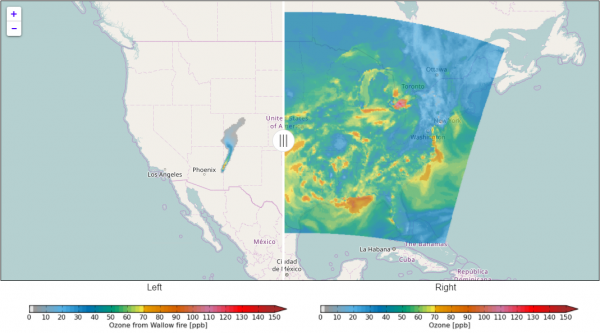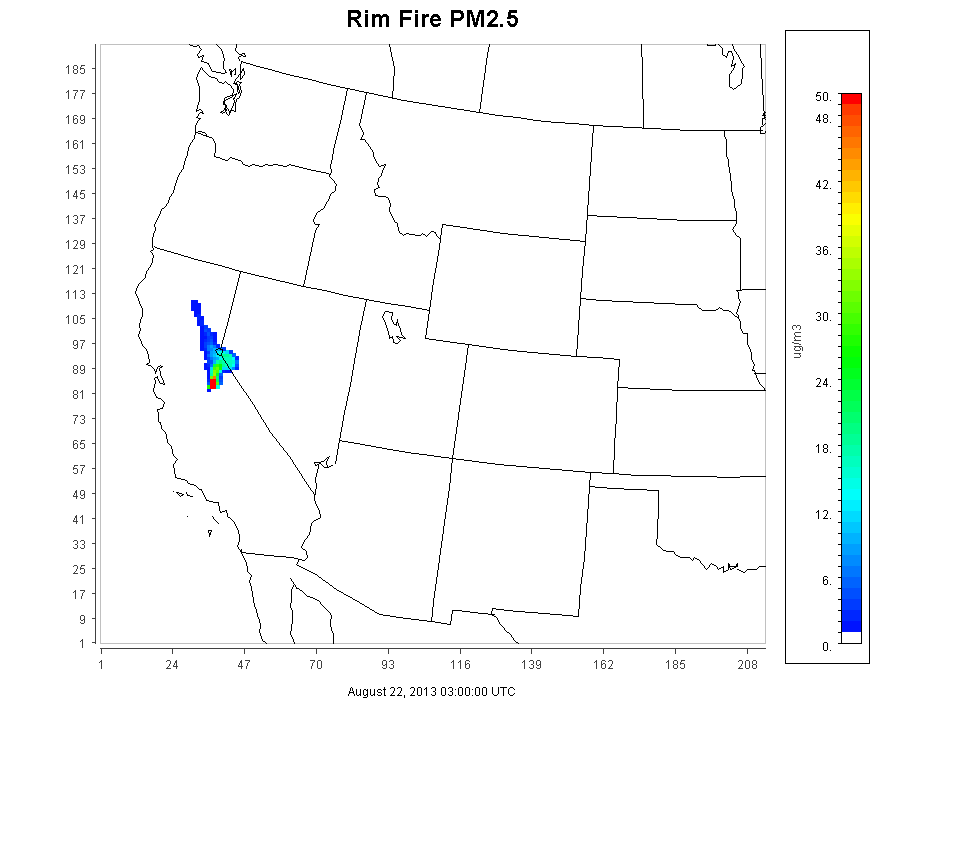Wildland Fires in CMAQ
Wild and prescribed (together called wildland) fires emit smoke that can strongly impact air quality both near the fire and far downwind. Wildland fires can also impact water bodies and soil when smoke particles settle out of the atmosphere or are removed through rainfall. Information about the type of trees in an area and the amount of the area that was burned is used to estimate wildland fire emissions. CMAQ then models how those emissions are transported downwind and react in the atmosphere.
Steps in the CMAQ Modeling Process:
 The map above shows ozone produced from the Wallow Fire in Arizona in 2011 compared to the ozone produced from all emissions sources during the same time period.
The map above shows ozone produced from the Wallow Fire in Arizona in 2011 compared to the ozone produced from all emissions sources during the same time period.
- Wildland fire location and size are determined using satellite information and also reports from local, state, and federal agencies.
- Wildland fire emissions are based on vegetation amounts and vegetation-specific emission factors using the freely available Bluesky framework Exit.
- Daily wildland fire emissions are input to CMAQ, which simulates transport, chemistry, and deposition.
- CMAQ outputs both ambient composition and deposition estimates for a multitude of pollutants including ozone (O3), particulate matter (PM), and air toxics (formaldehyde, mercury).
- CMAQ estimates of wildland fire impacts can be matched to places where people live to estimate community-based impacts on human health.
While emissions from fires have been treated in CMAQ for a number of years, observational studies have been infrequent and do not necessarily contain a large suite of measurements. New information will emerge over the next few years as part of planned field studies such as FIREX and FASMEE that will allow for more accurate and robust predictions of the impact of fires on air quality.
Watch a time-lapse of CMAQ predicted PM2.5 concentrations from a wildland fire in California

References
Baker, K.R., Woody, M.C., Tonnesen, G.S., Hutzell, W., Pye, H.O.T., Beaver, M.R., Pouliot, G., & Pierce, T. (2016). Contribution of regional-scale fire events to ozone and PM2.5 air quality estimated by photochemical modeling approaches. Atmos. Environ., 140, 539-554.
Baker, K., Woody, M., Valin, L., Szykman, J., Yates, E., Iraci, L., Choi, H., Soja, A., Koplitz, S., Zhou, L. (2018). Photochemical model evaluation of 2013 California wild fire air quality impacts using surface, aircraft, and satellite data. Science of The Total Environment, 637, 1137-1149.
Zhou, L., Baker, K.R., Napelenok, S.L., Pouliot, G., Elleman, R., O'Neill, S.M., Urbanski, S.P., Wong, D.C. (2018). Modeling crop residue burning experiments to evaluate smoke emissions and plume transport. Science of The Total Environment, 627, 523-533.
Wilkins, J.L., Pouliot, G., Foley, K., Appel, W., Pierce, T. (2018). The impact of US wildland fires on ozone and particulate matter: a comparison of measurements and CMAQ model predictions from 2008 to 2012. Internatioanl Journal of Wildland Fire, 27, 684-698. https://doi.org/10.1071/WF18053
